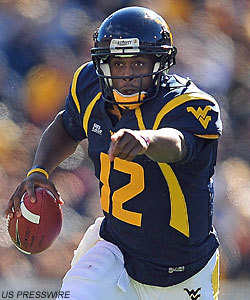Big 12 is back and better than ever

MORE:
Advertisement
Rivals250
It's July of 2011 in Dallas, and this is rock bottom for the Big 12.
It may not look like it, but it is. Conference commissioner Dan Beebe just
entered a Westin Galleria Hotel meeting room to the theme of The Natural.
There are free drinks at a makeshift bar just outside the room and embroidered
gift bags being handed out to reporters.
On the surface, the strangest conference media day in history appears to be a
premature celebration of the 10-team league's survival. A motivational video
about solidarity is being shown on a projection screen and athletic directors in
attendance are being hailed as conquering heroes.
Problem is, nobody's buying it. This is a plea, not a parade. The sound of palms
meeting faces is everywhere. Coaches are taking passive-aggressive potshots and
fingers are being pointed in all directions. Texas Tech's
Tommy Tuberville isn't even here. He's playing golf. Unbeknownst to most in the room,
for good.
The charade -- free booze and all -- is a façade. Just behind it lurks a
conference on the ropes. A banner reading "please believe in us" might as well
be hanging from the celling.
Then, change.
Fast-forward to the present, and the new Big 12 is a legitimate powerhouse. It
has a new commissioner and a pair of teams in the national title hunt. It's home
to last year's Heisman Trophy winner and this year's frontrunner. In just one
season, it has staked claimed to a spot near the summit of the sport.
As for the very real concerns of not so long ago?
"We're quickly gaining the reputation for being one of the best, if not the
best, conferences in the country," Texas head coach Mack Brown
said on Monday. "We went from possibly not having a league to having an unstable
league to having a league that wasn't getting along to having as stable a league
as anyone with great football teams and a commissioner that is very well
respected across the country."
Don't think it hasn't affected recruiting, either. Tuberville, one of the old
Big 12's harshest critics, is familiar with the challenges of convincing high
school players to join an unstable league. He had to do it once and thanks the
stars every now and again that he doesn't have to do it anymore.
"Now, nobody can point at any of us and say, 'Hey, don't go to school there
because they don't know what conference they're going to be in,'" Tuberville
said. "Now, everybody signed a contract and we're all in it together. We're off
and running."
The situation Tuberville speaks of was common for a time. Blueblood programs
like Texas and Oklahoma never came face to face with it. They were
assured a soft landing regardless of the outcome. Everyone else had to manage
the paranoia on high school campuses. So while Brown declines to delve into the
challenges instability created on that front, Tuberville speaks pointblank.
"Oh yeah, it happened," he said. "Players questioned it and questioned us. I'd
say probably 25 percent questioned it because it was being brought up by the
other coaches in the other leagues. If you put that thought in somebody's mind,
they're going to come and ask the question. And they did."
Questions didn't always come from prospects, though. Parents were among the most
skeptical. For every concern a player had about committing to a team in an
unstable league, his mother had three. For at least a year, it was status quo.
"You couldn't give them that certain suggestion as far as, 'We know we're going
to be here and not playing games on the East Coast or West Coast,'" Tuberville
said.
Today, of course, things are different. Four of the Big 12's 10 teams are ranked
in the top 15 of both major polls. Four more reside among the top 35 in the
Rivals.com
recruiting rankings. Questions from potential players are now about things like
high-scoring offenses, facilities and early playing time.
The ripples have spread in a hurry. Instead of seeing a league with a
questionable structure and an uncertain future, the Big 12's name now harkens a
different reaction. The first thing outsiders think when they hear it today?
"A power conference," said Tucson (Ariz.) Salpointe High School's Cameron Denson, who projects as one of the nation's best wide receivers in the
class of 2014. "It's one of the top leagues in the country. That's how we see
it."
Still, according to Oklahoma's
Bob Stoops, saying things are back to
normal is a bit of a misnomer. See, the word "normal" implies life has been this
good sometime in the past.
"I think the league is stronger now than it has been," he said. "I think we're
in great shape now. I had concerns myself the last two years. There's just
strength in our league now … good teams that are locked into this deal."

Click Here to view this Link.

Click Here to view this Link.
[rl]